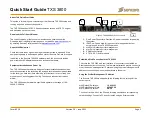
SATELLINE-M3-TR3,
–
TR4 and -R4
Integration Guide, Version 3.4
35
9.7
Error checking
When the error checking is switched on, the radio will add a checksum to the transmitted data.
When the data is received, the checksum is verified before data is forwarded to the serial port.
Options for error checking can be accessed either via SL commands or Configuration Manager
SW. Setting must be set equally for all radio modems in the same network. Error Check modes:
OFF (default setting).
Received data is not verified at all. In practice, this is the fastest way to
operate, because the data is given out from serial port immediately after it has been received.
This is recommended method, if the application protocol already includes error checking
functions.
CRC8 Partial
verifies the data in small blocks and they are delivered to DTE as sub messages after
validating. Once an error is detected, the rest of the message is ignored. In practice, if the error
appears in the middle of the message, the first part is forwarded to DTE and the data in
erroneous sub-message and after that will be lost.
CRC16 Full and CRC 8 Full check
adds checksum characters accordingly at the end of the user
data message. At the reception end the receiver receives first the whole package and if the
checksum matches the data message is forwarded to the serial port.
9.8
TX Delay
The transceiver can be configured to delay the beginning of a radio transmission by 1...65000
ms. The function can be used to prevent packet contention in a system, where all substations
would otherwise answer a poll of a base-station simultaneously. During this delay data sent to
the radio modem is buffered. Even when the priority setting is "RX", the radio modem is
prevented to change over to the receiving mode during the period of the TX delay. If TX delay is
not needed, its value should be set to 0 ms.
9.9
Add RSSi to data
RSSI info "\02RSSI:-nnn dBm\03" will be concatenated to the end of serial port messages, nnn is three
digit decimal number.
9.10
Separate TX/RX frequencies
Modem can transmit (TX-frequency) and receive (RX-frequency) on separate frequencies. The
switch between the frequencies introduces an extra 40 ms delay in the data transfer that must
be taken account when designing the system.
9.11
User data whitening
















































